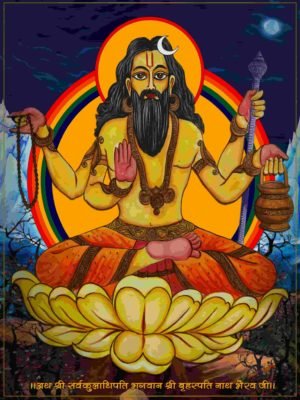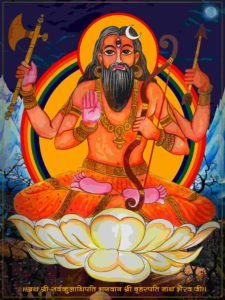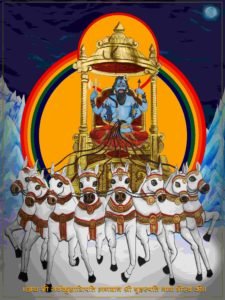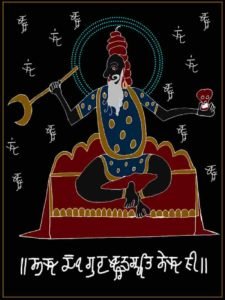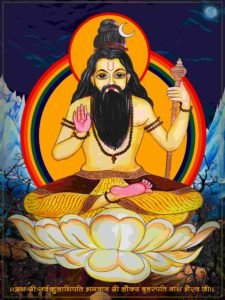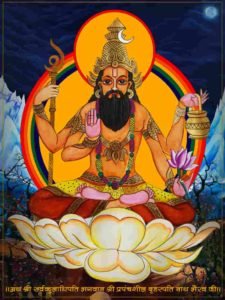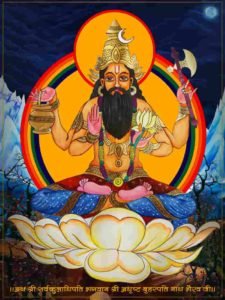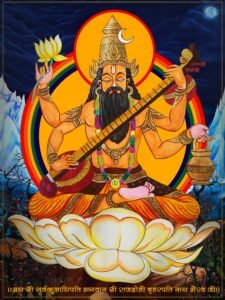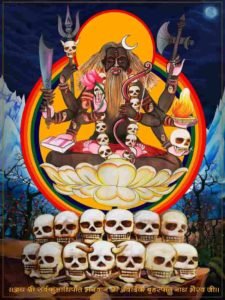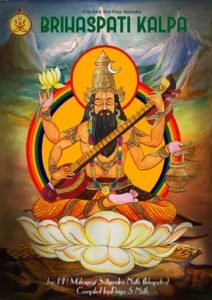Brihaspati, as per ‘Siddha Dharma’ is believed to be a Mahasiddha Brihaspati Nath, who was the Guru of all gods. He was believed to be so powerful that he defeated Indra many times in war. Lesser known fact is that Brihaspati was also a warrior Guru who along with devtas had defeated many daityas and danavas. He was very influential in always keeping the supremacy of gods over demons. He is portrayed as a very soft personality in the public domain by writers but ‘Siddha Dharma’ believes the contrary. He was a warrior guru who had strict adherence to sense of duty and dharma that he never allowed his pashutva to take over his devatva.
As per ‘Siddha Dharma’, Brihaspati is from the family lineage of Maharishi Angira Nath. He because of his extraordinary understanding of the smritis and text, agama and nigama, he was able to become the guru of the gods. Furthermore, he was a great devotee of Lord Shiva and Ma Parvati and he had directly received various teachings of agama and nigama directly from them. He also received lots of wisdom from his father too.
As per ‘Siddha Dharma’, he is light yellowish in color and he wears saffron cloth symbolizing purity and strict adherence to dharma and furthermore he is believed to reside in his loka called ‘Brihaspati Mandala”.
Etymology
The word ‘Brihaspati’, as per ‘Siddha Dharma’ is made up of two words (briha + pati), where briha means great and pati means lord or master. So the synthesis of the two words infer ‘Brihaspati’ to be the lord or master of great numerous wisdoms.
As per the ‘Siddha Dharma’, ‘Brihaspati’ also mean (briha+pati), where ‘Siddha Dharma’ interprets Brihaspati as the master of all masters. Furthermore, Brihaspati also at the time of his birth, started to recite prayers so his parents named him ‘Brihaspati’.
The ‘Siddha Dharma’ believes that he was anointed the gurus of the god because he had mastery over many great numerous wisdoms. Therefore, he not only had mastery over astika but also nastika system. He was also masters of various yogas like ‘Vrata Yoga’, ‘Vajra Yoga’ which he taught to Indra and other gods.
Brihaspati is also known for his extensive work upon the nastika or ‘ihaloka gyana’ based on sthoola (matter). Even the best among the materialist and hedonist, Maharishi Charvaka Nath was in his discipline lineage succession.
In Jyotish, he also holds a prominent place and symbolizes austerity and good omen but the ‘Siddha Dharma’ doesn’t resonate with how he is portrayed by the modern day jyotisha which shall be explained somewhere below.
Family lineage of Brihaspati
As per ‘Siddha Dharma’, Mahasiddha Brihaspati Nath is considered to be the son of Mahasiddha Angiras Nath and Surupa. There are lot of text in the public domain which mentions Smriti and not Surupa to be the mother of Brihaspati but the ‘Siddha Dharma’ believes them to be one. Surupa and Smriti are the same person but in different name. Mahasiddha Angiras Nath was the manasputra of Lord Brahma. Therefore, Mahasiddha Brihaspati Nath is the grandson of Lord Brahma.
As per ‘Siddha Dharma’, he had four wives. They were Tara, Subha, Mamta and Suniti. Tara is also known as Taraka in some texts. She had one daughter and seven sons. The foremost son of Brihaspati who is very popular in Jyotisha is Budha or the Budh graha.
Subha and Brihaspati had seven daughters and no son. They were Bhanumati, Raka, Archishmati, Mahamati, Mahismati, Siniwali, Havishmati.
Brihaspati had two sons with his third wife Mamta. They were Maharishi/Mahasiddha Bharadwaja Nath and Mahasiddha/Maharishi Kach Nath. Mahasiddha Bharadwaja is also believed to be one of the saptarishi and he is from the descendent of Maharishi Angiras. He also has a gotra in his name. Mahasiddha Dronacharya and Mahasiddha Aswathama Nath had their gotra as Bharadwaja.
Mahasiddha Kach Nath is mentioned in various religious texts where Brihaspati had sent him to Maharishi Shukracharya to learn the ‘Mrit Sanjeevni Vidhya’. He was able to learn it from Maharishi/Mahasiddha Shukracharya Nath because though he being a guru of the daityas, he could not differentiate anybody when it came to imparting wisdoms. Furthermore, Mahasiddha Brihaspati Nath also believed that Mahasiddha Sukracharya Nath to be the perfect guru for his son Mahasiddha Kach Nath to learn “Mrit Sanjeevni Vidya’. With the aid of this vidya, Mahasiddha Kach Nath helped his father in aiding gods at the time of war against the daityas and danavas.
Mahasiddha Brihaspati Nath had no children with his fourth wife, Suniti.
He has two brothers, Samvarta and Uttatthya. He didn’t get along with his brother Samvarta.
Teachings and Schools of Brihaspati
As per ‘Siddha Dharma’, the name ‘Brihaspati’ itself signifies that he is the master of numerous wisdoms. He has authored various texts like nitisastra, dharamsastra, vastusastra and vrihaspati smriti. He also propounded many wisdom forms for the betterment of the gods and the society. He is very influential in propounding the ‘Astika School’ of thoughts as well as the ‘Nastika School’ of thought i.e. ‘lokayata’. His most important two schools of thoughts are explained below.
Nastika school of brihaspati
As per the legends of ‘Siddha Dharma’, when once daityas were more powerful then the gods because of the penance and direction of Mahaguru Shukracharya, the gods and their guru, Mahasiddha Brihaspati Nath had to come up with a solution to solve the issue permanently. Every time the daityas and danavas were killed in the battle, Mahaguru Sukracharya through his penance power would utilize the ‘Mrit Sanjeevni Vidya’ and resurrect the daityas and danavas. They were virtually impossible to beat because they were guided to penances by their guru Mahaguru Shukracharya. They would please Lord Shiva, Lord Brahma and then receive boons so as to defeat the gods and conquer swarga or heaven. The gods had a hard time fighting every daityas and danavas. Therefore, Mahasiddha Brihaspati came up with the idea of ‘Nastika School of thought’ for the permanent solution of the problem.
The legend of ‘Siddha Dharma’ says that when Mahaguru Sukracharya went to the Himalayas to perform penance, Mahaguru of the gods, Brihaspati Nath took the form of his bitter rival Mahaguru Sukracharya and went to the daityas and danavas to initiate them into the wisdom of ‘lokayata’ to delude them from the real knowledge of the self and they would only be indulged into the empirical knowledge and would not perform penances to receive the boons from Lord Shiva. Since, empirical knowledge is the knowledge obtained through the senses and they believe that the only valid knowledge of reality is the empirical knowledge because it can be known through the senses, the daityas and danavas would be indulged in the gratification of the senses and then would not perform penances and also not be able to achieve spiritual powers to combat the gods.
The empirical knowledge about sthula or matter was the ultimate conspiracy against the daityas and danavas because Brihaspati designed all the wisdoms in such a way that they wouldn’t go for the real knowledge and acquire the powers to conquer heaven. They would then be indulged in sense pleasure and then it would ultimately lead them to their destruction.
Twelve forms of Brihaspati
As per ‘Siddha Dharma’, Brihaspati to forward the propaganda of empirical knowledge and wisdom, he created twelve Brihaspati from his body and they all propounded their respective wisdoms. Out of the twelve, five were Satwa Brihaspati and Rajas Brihaspati and the remaining two were Tamas Brihaspati.
As per ‘Siddha Dharma’, the names of twelve Brihaspati were Loukya Brihaspati, Angiras Brihaspati, Dev Guru Brihaspati, Arthagya Brihaspati, Kamagya Brihaspati, Avedik Brihaspati, Satark Brihaspati, Prapanchashil Brihaspati, Duruha Brihaspati, Rajadrohi Brihaspati, Adrista Brihaspati and Amokshi Brihaspati.
The five satwika Brihaspati propounded wisdoms related to buddhi (intellect), dharma, bala (strength and power), swasthya (health), dhana (wealth) and gyana (wisdoms) and laid down vital percepts for it. He said ‘Ishwara’ neither rewards anyone nor punishes anyone. It is humans own action that creates the karma. It is the karma that rewards or punishes an individual. He further said that the Ishwara that we look up to is nothing but our own selves. Therefore, the Brihaspati had put existence before Ishwara. He laid more emphasis of the existence of a human or a being then on the unseen, unknown and unknowable entity called ‘Ishwara’.
The two tamasic Brihaspati were the creators of “tarka and kutarka” (logics and sophism) and also the propounded of empirical science. He then imparted the ‘kamasutra’ wisdom to Mahasiddha Vatsyana Nath and then Vatsyana worked extensively on it and then infused the wisdom of ‘kamasutra’ to the society.
The five rajasic Brihaspati created and propounded various wisdoms like artha sastra (economics), nyaya sastra (justice system), niti sastra (ethics, moral) and propounded the knowledge to the society.
The ‘Siddha Dharma’ believes that one of the Tamas Brihaspati attacked Gayatri devi on her head and rejected her and the wisdoms related to her. The Brihaspati then started to create his own system of knowledge known as the ‘Loukya system’.
Laukika System of thought
As per ‘Siddha Dharma’ there are two systems of knowledge and they are laukika or vigyana also known as Nastika School. It is also known as empirical modern day science. The other system is the alaukika or paravigyana which is somehow similar to metaphysics. It is also the Astika School.
Loukika science was propounded by ‘Loukya Brihaspati’. It is also famously known as ‘Lokayata’ of Brihaspati. The Loukika system out rightly rejected Vedas as the source of knowledge and denied the existence of the soul. According to its principles, Loukika science only accepts ‘matter’ to be the ultimate reality. Therefore, this system is known as ‘materialist’ thought or the Nastika School because it doesn’t believe anything except the empirical matter. What is not experience by the senses is not believed. The ultimate form of any evidence can only be verified by the senses and not through the contemplation of things beyond matter.
Lokayata of Mahasiddha Charvaka Nath (Hedonism of Mahasiddha Charvaka Nath)
As per ‘Siddha Dharma’, Mahasiddha Charvaka Nath was the disciple of Loukika Brihaspati and he was quite influential in taking the ‘Brihaspati’s Lokayata’ to an extreme level of sthoola vigyana (materialism) and as well as to an extreme hedonism. He has an Upanishada attributed to his name and it is called as “Charvaka Upanishada”.
His philosophy of materialism is such popular that it is taken as one of the five heterodox system of Indian philosophy. The five heterodox system of Indian philosophy are “Jain, Buddhist, Ajivika, Ajnana, and Charvaka”.
He has a famous line in his hedonistic sutra called “Charvaka Upanishada” which is the ultimate text for reference for materialism. It says,
।।यावज्जीवेत्सुखं जीवेत्, ऋणं कृत्वा घृतं पिबेत्
भस्मीभूतस्य देहस्य पुनरागमनं कुतः
त्रयोवेदस्य कर्तारौ भण्डधूर्तनिशाचराः ।।
(The literal interpretation of the above precepts is, ‘When you live, live life full of pleasure. Borrow money and consume ghee (clarified butter) as when the body dies and becomes ashes, it is the end of life because there is no reincarnation. The three Vedas were created by false people who wanted to delude the society from the true knowledge of empirical matter.’)
As per “Siddha Dharma’, Mahasiddha Charvaka Nath was such hedonist and lokayata who took the wisdom of “Brihaspati’s Lokayata” forward, that according to him, the pleasure of the body is the heaven and the pain to the body is hell. His philosophy was all about pursuit of bodily pleasure and condemnation of bodily pain.
He said that one should live such a life full of pleasure that one should even borrow money to consume ghee (clarified butter). The ghee is the purpose of the milk. When milk is reduced and saturated to the extreme indivisible point then it becomes ghee. Ghee is the finest refinement of milk. Ghee is the most rajasic substance and he advocates consuming ghee even by borrowing money.
The modern day ‘credit card’ system is also the outcome of Charvaka hedonism. People get credit card for simple collaterals like proof of pay slip. People use the money of the bank to live a pleasurable life to enjoy the finest substance in the earth. Many people die without paying the debt of the bank because the bank cannot claim the money from the dead unless there is some physical collateral from where the debt could be recovered.
Astika school of Brihaspati
Although Brihaspati was the main propagator of the Nastika School to delude the society, he was also very influential in propounding the Astika School of thoughts. He was the guru of the gods; therefore his prowess lied in the ultimate Astika School of thought which he imparted to the gods.
As per ‘Siddha Dharma’, the Astika School of thought is also known as ‘Paravigyana” or “Alaukika”. It is somehow similar to ‘Metaphysics’ which means ‘beyond physics’. Since, physics deals with matter, metaphysics is transcending matter to go to the abstraction of anything. ‘Metaphysics’ is the antonym of ‘empirical science’ because metaphysics deals with topics which transcend sense experiences.
As per the ‘Siddha Dharma’, the ‘Astika School’ is believed to be more complicated and difficult than that of the ‘Nastika School’. Nastika School believes in empirical knowledge because it is the easiest form of knowledge because it needs no penance and austerity to know the things of the world but when a person intends to know the things beyond the empirical knowledge then ‘penance’ comes into play. To transcend the senses, one should perform penances because it is not a child’s play to transcend the ‘panchkoshas’ of the body.
Furthermore, the empirical knowledge is self evident because it is visible. The alaukika is something which has to be figured out and inferred from the depth of penances. The concept of ‘soul’, ‘reincarnation’ can only be known through ‘Alaukika ’or ‘Astika School’ because one has to transcend the senses first, then the body and then the mind. When mind is transcended, then soul is known.
As per ‘Siddha Dharma’, the main aspects of the ‘Astika School’ of thoughts are as follows,
- One should be a believer in the existence of the ‘Ishwara’.
- One should first transcend logic because logic is the outcome of mind. To transcend logic is the first step to transcend the mind. Furthermore, logic stops one from being a believer because the extreme reasoning always creates skepticism and ‘skepticism’ is what astika school do not advocate
- It rejects ‘matter’ to be the ultimate reality and embraces the concept of ‘soul’. It rejects materialism in the pursuit of the adhyatma (knowledge of the self). It puts oriental metaphysics before the empirical knowledge.
- Astika School is also the school which embraces eternity. Since, soul is considered to be eternal and only the body dies. Therefore, the essence and existence of any human beings is eternal. It is the soul that is eternal. It is the body that changes it shapes and forms.
- They are hardcore believer in reincarnation. It is the body that dies and not the soul. Therefore, the Astika School believes that the concept of ‘avatara’ is possible because it is consciousness that finds the body to be reborn again as human.
Relationship with Maharishi Shukracharya
As per ‘Siddha Dharma’, ‘Mahasiddha Brihaspati Nath’ and ‘Mahasiddha Shukracharya Nath’ were bitter rivals. The former the Guru of the gods while the latter, the Guru of the daityas and danavas. They never went along their whole life except for some instances.
Brihaspati was an astika and he had put ‘Ishwara’ before anything in this universe. He adhered strictly to both the Vedas and the ‘Agama-Nigama’ of Lord Shiva and Ma Parvati. He being the grandson of Lord Brahma strictly worshipped Gayatri to transcend the Prajapatis. It was only to delude and fool the daityas and danavas he orchestrated an attack on Gayatri to make it more believable for the daityas and danavas. He played a masterstroke which caused the ultimate downfall of the daityas and danvas in the long run.
Mahasiddha Shukracharya Nath, the son of Maharishi Bhrigu Nath was no less than Brihaspati. He was rejected by the gods therefore out of agony; he became the guru of the daityas and danavas. It was because of him the daityas and danavas became very powerful and always gave constant threats to the gods. His disciple ‘Mahasiddha Jalandhara Nath’ was so powerful that he is believed to have even defeated Lord Shiva in the battle because of the power of his shakti, Vrinda.
They were bitter rivals but they both agreed and worked together when Brihaspati rejected the astika and propounded the nastika. When Brihaspati attacked the Veda mata Gayatri, Mahasiddha Shukracharya Nath became very pleased and happy, they both then worked together to form a new sastra called ‘Prawanchan Sastra’.
Furthermore, Brihaspati also sent his son Mahasiddha Kach Nath to Shukracharya to learn ‘Mrit Sanjeevni Vidhya’. Shukracharya taught Kach the vidhya and then he used it to help his father to fight against the daityas and danavas.
Misconception in jyotish sashtra
As per ‘Siddha Dharma’, there is a great misconception about Mahasiddha Brihaspati Nath and his son Mahasiddh Buddh Nath. The jyotishacharya have wrongly presented the story of the relationship of the moon god with his guru’s consort Tara.
The ‘Siddha Dharma’ doesn’t believe that Mahasiddha Buddh Nath, was the son of moon god, Chandrama and Tara. Buddh was the son of Mahasiddha Brihaspati himself.
As per the legends of ‘Siddha Dharma’, in the ‘Vitala Loka’, a daitya called ‘Tikshna Hasta’ performed penance of Lord Shiva and then when Lord Shiva manifested before him; he asked the boon to defeat ‘Brihaspati’. He was then granted the boon to defeat Brihaspati. His main intention behind such penance was to publicly humiliate and defame Brihaspati such that he dies the death of a fallen man. He wanted Brihaspati to become such humiliated that the whole triloka shall despise Brihaspati.
He then went to war with Brihaspati and when Brihaspati realized that the daitya was blessed by Lord Shiva, he didn’t raise any arms and he surrendered. When Brihaspati was captured and taken into custody, his consort Tara was pregnant and had Buddh in her womb. The moon god, Chandrama was also present with her. Chandrama knew about the boon of ‘Hasta Tikshna’ and he had an enormous love for both his guru, Brihaspati and his Guru’s consort, Ma Tara. He had enormous love for his gurumata, Tara.
Chandrama then devised a plan to delude ‘Hasta Tikshna’ so he convinced gurumata to follow his plan to delude the daitya. He then created a false propaganda that when Brihaspati was captured and taken into the custody, the gurumata Tara had eloped with Chandrama. He hyped it to such extent that it reached the ears of ‘Hasta Tikshna’ in no second. Hearing it, the daitya became very happy because his whole purpose was served. He wanted to defame Brihaspati to such great extent and insult him but he was happier that Chandrama’s action was the best revenge. Lesser did he know that it was ploy set up by Chandrama to delude him.
Brihaspati knew about it and he had full trust on his consort Tara as well as his disciple Chandrama. But even he kept quiet and along him all the gods kept quiet. He was then released by the daitya to face the wrath of the divine world. He then went to Buddh and accepted him as a son and for the daityas they felt, it was his act of saving his dignity to which they laughed it away. Mahasiddha Brihaspati then adviced his son Buddh for penances for two reasons. First for the purpose of self development and secondly to delude the daityas that Buddh was performing the penances to relieve himself from the sins of being an illegitimate child.
The whole act was done with such great planning and excellence that the daityas never inferred the truth. They were very happy with their own delusion. As per ‘Siddha Dharma’, it was the daityas that were eventually deluded in the long run.
Therefore, the ‘Siddha Dharma’ believes that the whole story of Buddh being the son of Chandrama and his gurumata Tara is completely hoax and false. It was only done to delude the demons and with the demons the society also became deluded.
The whole narrative in the sastra as well as the jyotish text is nothing but misinterpreted facts.
Iconography
As per ‘Siddha Dharma’, Brihaspati is not only a scholar but also a warrior guru. He is considered to be the lord of buddhi (intellect) and gyana (wisdom). He is portrayed in three different forms.
The Satwa form
The first form is his satwik form where he is depicted as light yellow saffron color complexion and attire. He is portrayed with four hands which hold danda, rudraksha rosary, kamandalu and a hand performs vara mudra. His satwik form depicts him to be an ascetic who performs penance, he can give boons out of his penances and he can also punish and maintain justice.
The Rajasic form
His second form is the rajasic form where he is portrayed with four hands. The four hands holds bow and arrows, golden axe and the last hand is depicted with vara mudra. He is pictured in padmasana wearing golden ornaments. The ornaments are meticulously worked upon.
The rajasic form depicts him to be a warrior guru who is warrior in nature plus he is the guru of the gods so his ornaments are meticulously worked upon. It symbolizes the peak of rajas. He is also able to bestow boons based on his penance.
The Brihaspati in public domain is pictured as holding conch shell, disk, vara and abhaya mudra is not as par as the Brihaspati of ‘Siddha Dharma’ because he has been portrayed as a very simple deity devoid of the very essence of him.
The Tamasic form
His third form is the tamasic form where he is depicted as a warrior with golden color chariot that is pulled by eight light red horses. With his one hand he holds the strings of the horses, the second hand holds a golden axe, another hand holds a bow and the other hand holds an arrows.
This form denotes his warrior form ready for war. This form denotes that he is warrior to protect dharma from intruders. The golden chariot is as effulgent as the sun itself.
The schools of Mahasiddha Brihaspati
Mahasiddha Brihaspati Nath, the guru of the devtas, is one of the prominent Mahasiddhas of Siddha Dharma along with his rival Mahasiddha Shukracharya Nath. He is believed to be one of the eternal ‘Guru Mandala’ of Siddha Dharma as because of him the ‘Siddha Dharma’ still exist in today’s modern day and age.
The Siddha Dharma believes that he was real architecture of the modern day Hindu Dharma. It also believes that the Hindu Dharma is the amalgamation of numerous wisdoms which are saturated to fit under the umbrella of Hinduism. The two major schools of Hindu Dharma are the Astika and the Nastika. All the darshana and philosophy of Hindu Dharma fits in either of the two. The Siddha Dharma also believes that the Hindu Dharma therefore incorporates both orthodox (Astika) and heterodox (Nastika) school of thoughts.
Nastika and Astika School of Brihaspati
As per Siddha Dharma, Mahasiddha Brihaspati Nath is a prominent figure of Hindu Dharma as he is considered to be the source of both Astika and Nastika School of Hinduism. He is the source from where the two streams of Astika and Nastika darshana flows. It was the influence of him that both the schools (Nastika and Astika) incorporated major thoughts and darshana of his magnus opum, Brihaspati Kalpa. So, the whole idea of Hindu Dharma is incomplete without him and his darshana and teachings.
As per the Siddha Dharma, the six orthodox (Astika) schools of Hinduism are
- Nyaya
- Vaisheshika
- Samkhya
- Yoga
- Mīmāṃsā
- Vedanta
The five heterodox (Nastika) school of Hinduism are
- Jain
- Buddhism
- Ajivika
- Ajñana
- Cārvāka.
Mahasiddha Brihaspati Nath in short is the source from where the two streams of Nastika and Astika school of Hindu Dharma flows. His ‘Astika Darshana’ was adopted by various Mahasiddhas like Gautama Nath in Nyaya, Mahasiddha Kapila Nath in ‘Samkhya’, Mahasiddha Kanada in ‘Vaisheshika’ , Mahasiddha Jaimini Nath in ‘Mimansa’ while as ‘Yoga’ school of Hindu Dharma follows both Nastika and Astika darshana of Brihaspati. Yoga starts with Nastika and then ultimately ends in Astika. In Yoga school, Nastika darshana is the means while as the Astika darshana is the end. So, Yoga falls under the Astika school of Hindu Dharma.
‘Nastika Darshana’ was adopted by one of his prominent disciple, Mahasiddha Charvaka Nath in Charvaka Upanishada. Both Buddhism and Jainism also directly reject the authority of Vedas and incorporated the precepts laid down by Avedic Brihaspati. The ‘Ajivika School’ is also influenced by Avaidik Brihaspati while as the ‘Ajnana School’ which is also considered to the radical skepticism school of Hindu Dharma incorporated the precepts laid down by the two tamasic Brihaspati (Avaidik and Kamagya Brihaspati) as the two Brihaspati were the creators of ‘logic and Sophism’ (tarka and kutarka).
As per ‘Siddha Dharma’, to understand the above Astika and Nastika darshana of Brihaspati, one should first thoroughly understand the two basic primary philosophies of Brihaspati i.e. Loukika and Paraloukika.
Basics philosophies of the schools of Brihaspati
As per ‘Siddha Dharma’, there are basically two primary philosophies of Brihaspati which is the underlining philosophy of his Nastika and Astika Darshana. These two philosophies is the foundation upon which the ‘Nastika and Astika Darshana’ is based.
Loukika (इहलोक)
The ‘Loukika’ system of thought basically means the philosophy of ‘this loka’ i.e. earth and our surroundings. Our interaction with this loka is basically done with our body, mind and with the help of the five senses (ज्ञानेन्द्रिय) of our body. Therefore, as per loukika thoughts, truth is something which is empirical i.e. perceived by the senses (indriya janita gyana). It straightly rejects knowledge and wisdoms which are not based on empiricism or the direct sense perception.
As per ‘Siddha Dharma’, the loukika thought is also the basis of skepticism. Skepticism is based on the notion that the truth should be based on empirical reality and whatsoever knowledge derived from anything except the sense perceptions are mere speculations. The speculations are nothing but the foundation of dogmas. Dogma is something which does not have valid empirical evidences or pramana and is the subjective view of a perceiver which may or may not be true.
Therefore, Nastika Darshana of Brihaspati was based on his loukika system of thoughts. Nastika Darshana utilizes skepticism to such great extent that it rejects everything. It doesn’t leave even a single room for any possibilities. It questions all the belief that one possesses and when the skepticism is taken to an extreme then it becomes radical skepticism. The radical skepticism doesn’t believe in the existence of anything beyond empirical matters. Unless witnessed, it doesn’t believe in the existence of anything.
Nastika is narrowly translated as ‘atheism’ in western philosophy which is half baked truth. Nastika is an umbrella term for all skepticism of existence beyond empirical reality. The concept of Ishwara in Hindu Dharma is not an empirical fact because Ishwara is a realization beyond the senses. Therefore, Nastika Darshana doesn’t believe in the existence of Ishwara because the concept is not based on empiricism.
As per ‘Siddha Dharma’, the translation of Atheism as Nastikta is also not as par with our definition of Nastikata. Atheism is a view which does not believe in the existence of God while as Nastikta is a view that doesn’t believe in anything metaphysical be it God or anything else.
Paraloukika
The ‘Paraloukika’ system of thought of Brihaspati is beyond empiricism i.e. beyond sense perceptions. It believes that the ultimate truth i.e. Ishwara is beyond empirical reality because senses are under the mind and Ishwara is something beyond mind. At the deep state of Samadhi, when all activities of mind are suspended, the yogi then realizes the existence of Ishwara.
As per ‘Siddha Dharma’, Paraloukika School of thoughts is by nature believer in metaphysical reality (परलोक). It also believes in the Shruti and Smriti of the Dharmic texts. The Shrutis and Smritis is not based on the first hand experience of any person other than the propounder but the followers still believe it because they believe it to be true. Skepticism has no place in ‘Paraloukika’. In fact, Paralaukika considers skepticism to be the death of all adhyatmik pursuit because even the soul (आत्म) is not empirical reality. If a person straightly rejects the existence of soul then the person can never ever realize the existence of their soul because the very belief based on skepticism doesn’t encourage the person to do so.
As per ‘Siddha Dharma’, the very translation of ‘theism’ into Astika is also half baked truth. Astika means the believer in existence beyond empirical reality and sense perceptions and Theism is just a perception which believes in the existence of god and also the devil. Theism only believes in the existence of god but Astika believes in many empirical realities besides God. For instance, a Theist has nothing to do with the existence of ‘Brahma Kamala’ in the Hanskunda area of Himalaya but the Astika believes in it as they do not reject anything.
Three forms of the Nastika School of Brihaspati
As per the legends of ‘Siddha Dharma’, Brihaspati had himself created his twelve forms after rejecting the Gayatri Devi and the supremacy of Veda. He then propounded the Nastika Darshana to the world. Out of the twelve forms he created, five were Satwik, five Rajasic and remaining two forms were Tamasic forms. All the forms created different types of wisdoms and then imparted it to the society.
Satwika Kula
The Satwik Kula of Brihaspati were propounded by the five Satwika Brihaspati. The satwika Brihaspati are as follows:
1) Devaguru Brihaspati (देवगुरु बृहस्पति)
2) Loukya Brihaspati (लौक्य बृहस्पति)
3) Angiras Brihaspati (अंगिरस बृहस्पति)
4) Arthagya Brihaspati (अर्थज्ञ बृहस्पति)
5) Satarka Brihaspati (सतर्क बृहस्पति)
The above five Brihaspati were very instrumental in propounding various wisdoms related to buddhi (intellect), dharma, bala (strength and power), swasthya (health), dhana (wealth) and gyana (wisdoms) and laid down vital percepts for it. They said that the ‘Ishwara’ neither rewards anyone nor punishes anyone. It is humans own action that creates the karma. It is the karma that rewards or punishes an individual. They further said that the Ishwara that an individual looks up to is nothing but their own selves. Therefore, the Brihaspati had put existence before Ishwara. He laid more emphasis of the existence of a human or a being then on the unseen, unknown and unknowable entity called ‘Ishwara’.
Rajasic Kula
The five rajasic Brihaspati were very instrumental in propounding various wisdoms like artha sastra (economics), nyaya sastra (justice system), niti sastra (ethics, moral). The present day philosophies of Jurisprudence (Vidhi Sastra), Economics, Politics, Ethics etc were all propounded by Brihaspati to enrich the life of human beings.
The five Rajasic Brihaspati are as follows:
1) Amokshi Brihaspati (अमोक्षी बृहस्पति)
2) Prapanchashil Brihaspati (प्रपंचशील बृहस्पति)
3) Adhrista Brihaspati (अधृष्ट बृहस्पति)
4) Duruha Brihaspati (दुरूह बृहस्पति)
5) Rajadrohi (राजद्रोही बृहस्पति)
The Rajasic Kula of Brihaspati was all about enriching life with beauty so that life becomes worthy of living. He infused the kula with rajas tatwa. The rajas tatwa is the epitome of passion. Rajasic kula transforms a person into a passionate person. Brihaspati used that very rajas tatwa to propound various wisdoms for the betterment of the life of sadhaka.
Tamas Kula
The remaining two Brihaspati created the subtle art of logic and sophism (तर्क and कुतर्क). They propounded the wisdom in such a way that they made it believable that if not for empiricism, truth can still be reached through correct reasoning.
The two Tamasic Brihaspati are:
- Kamagya Brihaspati (कामज्ञ बृहस्पति)
- Avaidik Brihaspati (अवैदिक बृहस्पति)
The two Brihaspati were very influential in propounding and spreading wisdoms related to sense pleasure and anti-vedas. Logic and Sophism were anti-vedic by their nature. Since it was created by tamasic Brihaspati, the very essence of Logic and Sophism as per ‘Siddha Dharma’ had tamas as its basic foundation. Therefore, logic and sophism was merely an instrument for spreading of tamas. The modern day propaganda based on logic and sophism is its prime example.
Brihaspati Kalpa (ब्रहस्पति कल्प) and Courses on Brihaspati Kalpa
As per ‘Siddha Dharma’, Brihaspati kalpa is considered to be the ‘magnus opum’ or master piece of Mahasiddha Brihaspati Nath. The whole school of Brihaspati can only be understood if one first studies the Brihaspati Kalpa in depth. It contains all the wisdoms that are mentioned in above sections.
As per ‘Siddha Dharma’, Brihaspati Kalpa is considered to be the supreme texts for both Nastika and Astika Darshana of Brihaspati. To first understand the Brihaspati Kalpa, one should first understand the basic philosophies which are the foundations of it i.e. Loukika and Aloukika. Only when a person becomes adept in the major school of thoughts and the basic philosophies then the person can proceed to the mastery of Brihaspati Kalpa.
The Brihaspati Kalpa is the text that has five volumes and within those volumes there are sub-volumes to explain and clarify the volumes. The Furthermore, ‘International Kaulantak Siddha Vidhya Peeth’ also organizes the seven days course based on Brihaspati Kalpa.
The Brihaspati Kalpa with its volumes and sub-volumes is given below.
Brihaspati Kalpa (बृहस्पति कल्प)
Volume – 1 (खण्ड-1)
-Brihaspati Yoga Agama (बृहस्पति योग आगम)
-The origin of Yoga (योग की उत्तपत्ति)
–Which Yoga is the best among the 108 Yoga? (108 योगों में श्रेष्ठ योग कौन ?)
-The pragmatic and non-pragmatic parts of Yoga (योग के उपयोगी और अनुपयोगी भाग)
-Difference between Samadhi and Wholeness (समाधी और पूर्णता में अंतर)
-The gist of Brihaspati’s Yoga Kriya Yoga (बृहस्पति कृत योग क्रिया योग का सार)
-Kriya Yoga and Kundalini (क्रिया योग और कुण्डलिनी)
-The sub forms of Kriya Yoga (क्रिया योग की उपप्रकार)
-The Kriya Yoga methods (क्रिया योग की विधियां)
-The accomplishment of Kriya Yoga (क्रिया योग की उपलब्धि)
-Kriya Samadhi (क्रिया समाधी)
Volume – 2 (खण्ड-2)
-The Darshana of Brihaspati (बृहस्पति दर्शन)
-The twelve different forms of Devaguru and its necessity (देवगुरु के 12 स्वरुप और आवश्यकता)
-Satwa Guna, Satwa Universe and Satwika Humans (सत्व गुण, सत्व सृष्टि और सात्विक मनुष्य)
-Rajas Guna, Rajas Universe and Rajasic Humans (रजस गुण, रजस सृष्टि और रजस मनुष्य)
-Tamas Guna, Tamas Universe and Tamasic Humans (तमस गुण, तमस सृष्टि और तामसिक मनुष्य)
-The body and soul of Humans (मनुष्य आत्मा या शरीर)
-Are Humans alone in universe or derelict? ( ब्रह्माण्ड में अकेला या परित्यक्त?)
-The rights of Humans over Nature (मनुष्य का प्रकृति पर अधिकार)
-Necessities and Rules (आवश्यकताएं और नियम)
-The best precept for Humans (मनुष्य के लिए सर्वोपरि नियम)
Sub-volume – 1 (उपखण्ड-1)
-Astika Darshana (आस्तिक दर्शन)
–What is Astikata? (आस्तिकता क्या है?)
–Why Astikata? (आस्तिक क्यों हों?)
-The end of Astikata (आस्तिकता का अंत कहाँ है?)
-The virtues and vice of Astikata (आस्तिकता गुण या दोष?)
-Why are Humans not Astika? (मनुष्य आस्तिक क्यों नहीं हैं?)
-The practical use of Astikta (आस्तिकता के प्रयोग)
-Does Astikta help transcend death? (क्या आस्तिकता मृत्यु के पार ले जाती है?)
–Does Astikta merge with truth? (क्या आस्तिकता से सत्य मिलता है?)
-The synopsis of Astikta (आस्तिकता का सार)
Sub-volume – 2 (उपखण्ड-2)
-Nastika Darshana (नास्तिक दर्शन)
-What is Nastikata? (नास्तिकता क्या है?)
-Why to be Nastika? (नास्तिक क्यों हों?)
-Is there any end to Nastikata? (नास्तिकता का अंत कहाँ है?)
-Is Nastikata virtue or vice? (नास्तिकता गुण या दोष?)
-Why are Humans not Nastika? (मनुष्य नास्तिक क्यों नहीं हैं?)
-The practical use of Nastikata (नास्तिकता के प्रयोग)
-Does Nastikata help to transcend Death? (क्या नास्तिकता मृत्यु के पार ले जाती है?)
-Does Nastikata merge with Truth? (क्या नास्तिकता से सत्य मिलता है?)
-The gist of Nastikata (नास्तिकता का सार)
Volume – 3 (खण्ड-3)
-Rituals (कर्मकाण्ड)
-What are Rituals? (कर्मकाण्ड क्या है?)
-What is the pragmatic value of rituals? (कर्मकाण्ड की कितनी उपयोगिता?)
-The virtues and vice of Karmakanda (कर्मकाण्ड के गुण और दोष)
-Rituals its place, time and circumstances. (कर्मकाण्ड और देश, काल, परिस्थिति)
-The rules of Rituals (कर्मकाण्ड के नियम)
-The introduction of Rituals (कर्मकाण्ड का परिचय)
Sub-volume – 1 (उपखण्ड-1)
-Introduction of Vedic Rituals (वैदिक कर्मकाण्ड का परिचय)
-The Vedic Rituals styles (वैदिक कर्मकाण्ड की शैली)
-The mantra for Vedic Rituals (वैदिक कर्मकाण्ड के मंत्र)
-Vedic Ritual’s Yantra (वैदिक कर्मकाण्ड के यन्त्र)
-The virtue and vice of Vedic Ritual (वैदिक कर्मकाण्ड के गुण दोष)
-The gist of Vedic Ritual (वैदिक कर्मकाण्ड का सार)
Sub-volume – 2 (उपखण्ड-2 )
–(Tantrik) Avaidik Rituals and its Introduction {(तान्त्रिक) अवैदिक कर्मकाण्ड का परिचय}
– (Tantrik) Avaidik Rituals and its Styles {(तान्त्रिक) अवैदिक कर्मकाण्ड की शैली}
– (Tantrik) Avaidik Rituals and its Mantra {(तान्त्रिक) अवैदिक कर्मकाण्ड के मंत्र}
– (Tantrik) Avaidik Rituals and its Yantra {(तान्त्रिक) अवैदिक कर्मकाण्ड के यन्त्र}
– (Tantrik) Avaidik Rituals and its Virtues and Vice {(तान्त्रिक) अवैदिक कर्मकाण्ड के गुण दोष}
– (Tantrik) Avaidik Rituals and its Gist {(तान्त्रिक) अवैदिक कर्मकाण्ड का सार}
Sub-volume – 3, (उपखण्ड-3)
-The Introduction of Akula Rituals (अकुल कर्मकाण्ड का परिचय)
-The Style of Akula Rituals (अकुल कर्मकाण्ड की शैली)
-The Mantra of Akula Rituals (अकुल कर्मकाण्ड के मंत्र)
-The Yantra of Akula Rituals (अकुल कर्मकाण्ड के यन्त्र)
-The Virtues and Vice of Akula Rituals (अकुल कर्मकाण्ड के गुण दोष)
-The gist of Akula Rituals (अकुल कर्मकाण्ड का सार)
Volume – 4, खण्ड-4
-Why are Puranas and Tantra opposite paths? (पुराण और तंत्र विरोध मार्ग क्यों?)
-Which is truth, Purana or Tantra? (सत्य कौन पुराण या तंत्र?)
Sub-volume – 1 (उपखण्ड-1)
-Puranik Volumes (पुराणिक कोष)
-Why the need for Puratana wisdom and its necessity? (पुरातन ज्ञान क्यों आवश्यक?)
-How much is history truth and false? (इतिहास कितना सत्य और असत्य?)
-Conspiracies and passion for woman (षडयंत्र और क्षात्र वासना)
-Conspiracies and passion for pseudo intellectism (षडयंत्र और दुर्बुद्धि वासना)
-Facts and Propagation (तथ्य और जनप्रसार)
-Strategies, Propagandas and Lies (रणनीति, कुप्रचार और असत्य)
-The miseries of life and its uses (जीवन के दुःख और उनका उपयोग)
-Heart, its 5 disorders and Conspiracy (हृदय, 5 विकार और षडयंत्र)
Sub-volume – 2 (उपखण्ड-2)
-Tantrik Volumes (तांत्रिक कोष)
-Why is it necessary to be a tantric? (तांत्रिक होना क्यों आवश्यक?)
-What is History creation? (इतिहास निर्माण क्या है?)
-What is perfection and its importance? (सिद्धि क्या है और इसका महत्त्व क्या है?)
-What is the similarity and difference between perfection and deception? (सिद्धि और छल में क्या समानता और असमानता?)
-What is life, accomplishment or renunciation? (जीवन क्या है प्राप्ति या त्याग?)
-Why is tantrika shatakarma a need and also a liability? ( तांत्रिक षट्कर्म आवश्यक और दोषपूर्ण क्यों?)
-Why are Humans unsatisfied? (मनुष्य अतृप्त क्यों?)
Volumes – 5 (खंड-5)
-The fruitful actions and Therapies (काम्य प्रयोग और चिकित्सा)
-Tantrik methods (तांत्रिक विधि)
-Vedic methods (वैदिक विधि)
-Body and Health (देह और स्वास्थय)
-Body and Beauty (देह और सौंदर्य)
-Body and Passions (देह और वासनाएं)
-Fulfillment of desires and renunciation of desires (वासना पूर्ती और वासना त्याग)
-What is sexual desire? (काम क्या है?)
-What is the limitation of sexual desire? (काम की सीमा क्या है?)
-Sexual desires: virtue or vice? (काम वासना पाप या पुण्य?)
-The psycology of any passion (वासना का मनोलोक)
-Duties of householder, attractions and sins (गृहस्थ धर्म, आकर्षण और पाप)
-Incest, Prostitution and Love relationship (नियोग, वैश्यावृत्ति और प्रेम सम्बन्ध)
-The gist of philosophy of life ( जीवन दर्शन का सार)
– Awaiting Death ( मृत्यु की प्रतीक्षा)
Brihaspati as Designation
As per ‘Siddha Dharma’, Brihaspati is also a person and also a designation. The first Brihaspati created a standard. The later people who achieved the similar status were then also referred to as Brihaspati. It can also be explained by the concept of Shiva and Shakti.
Shiva (शिव) is made up of two words i.e. (शव+इ), that means Shiva becomes Shava when the Shakti is taken out from it. Therefore, Shiva is someone who is the controller or master of Shakti. A Shiva can never be devoid of Shakti or else he becomes a corpse. Lord Rudra is considered to be the first Shiva. Later, when Siddhas through sadhana reached his status, they were also referred to as Shiva. Therefore, Shiva is not merely a person but also a status. Similarly, Brihaspati is just not a person but also a designation like ‘Shiva’.
As per the Siddha Dharma, the designation of Brihaspati is given to someone who has perfected the ‘Brihaspati Kalpa’. The ‘Brihaspati Kalpa’ as mentioned in above section consists of both Nastika and Astika Darshan along with Tantra, Veda, Purana etc. So, a mastery of ‘Brihaspati Kalpa’ means a person who is adept in both Astika as well as Nastika Darshana, adept in Tantra and Veda, Rituals, Puranas etc.
The designated Brihaspati should be the master of both Loukika as well as Aloukika School. A Brihaspati is neither Nastika nor Astika but chooses a middle path. His darshana is all about taking the middle path or rajas path for the perfection of life and for the perfection of sadhanas.
The only misinterpreted fact of Brihaspati is that he is treated as a mere planet in Jyotisha which is completely false. The planet Jupiter is nothing but a medium to worship the very Brihaspati. The planet Brihaspati or Jupiter doesn’t have any relevance if the name of Brihaspati isn’t associated. For instance, a idol is considered god not because of what it is made of but the name associated with it. When any deity is invoked in an idol then the stone becomes god, similarly the planet Jupiter has its resemblance because it is linked with Mahasiddha Brihaspati Nath or else like the idol Jupiter is nothing but a big mass of gas.
Mahasiddha Ishaputra, the current Kaulantak Peethadheshwara also reached the state of Samadhi through the Yoga of Nastika Darshana of Brihaspati. Therefore, it is of paramount importance that Brihaspati sadhana should be undertaken from a capable Guru so as to perfect various system of knowledge.
International Kaulantak Siddha Vidhya Peeth
The ‘International Kaulantak Siddha Vidhya Peeth’ is a Dharmik institution based on ‘Siddha Dharma’ which extensively promotes the teachings of various Siddhas of ‘Siddha Dharma’ to the world. It is a registered institution which reserves all the rights to teach the various wisdoms of ‘Siddha Dharma’ as it is.
It is also an international institution of the ‘Siddha Dharma’ which works for propagating the teachings of Siddha Dharma to the International community. At the day and age of ‘Global Village’ when everything has become globalized, the ‘Siddha Dharma’ is not yet globalized. It has not yet been globalized because the ‘Guru Mandala’ didn’t permit anyone to preach it beyond Himalaya. It was in His Holiness Mahasiddha Ishaputra that the Guru Mandala found their trust. He has been given the mission to propagate the ‘Siddha Dharma’ in the global domain and with it also spreading the message of the ‘Siddhas’ to the world through the ‘Siddha University’. The ‘International Kaulantak Siddha Vidhya Peeth’ is more of the university of Siddhas where different wisdoms forms are taught.
For the sole purpose of spreading the message of ‘Siddhas’ to the world, the ‘International Kaulantak Siddha Vidhya Peeth’ as a trust has been registered which is a separate legal entity then Mahasiddha Ishaputra, which uses the expertise of Mahasiddha Ishaputra to propagate ‘Siddha Dharma’ teachings to the world.
Currently, the ‘International Kaulantak Siddha Vidhya Peeth’ has three centers in India. One in Kotla Village of Dharakhari, Himachal Pradesh, another in Rishkiesh, Uttarakhand and the other in Satara, Maharastra. Out of three centers, the International centre of Satara, Maharastra is operative but the infrastructure has not been finished. The Kotla village and the Rishikesh center are still under construction.
Any person in the near future who wishes to undertake the courses can contact the centers as mentioned.

